UGB108 Quantitative Methods for Business Alternative Assessment
VerifiedAdded on 2023/01/11
|7
|1091
|93
Report
AI Summary
This report presents a comprehensive solution to a Quantitative Methods for Business assignment, addressing key concepts and techniques. The report begins with a detailed analysis of statistical measures, including calculating the mean and standard deviation from grouped data, and interprets the results. It then explores different sampling methods, such as simple random sampling, quota sampling, sample frames, and cluster sampling, providing definitions and applications for each. The report further delves into regression analysis, explaining the meaning of regression coefficients and applying them to predict costs and make informed decisions. Finally, it tackles probability problems, calculating the probability of events using probability rules. The solutions are presented with clear explanations and calculations, demonstrating the application of quantitative methods in business contexts. The assignment covers topics like descriptive statistics, sampling techniques, regression analysis, and probability.
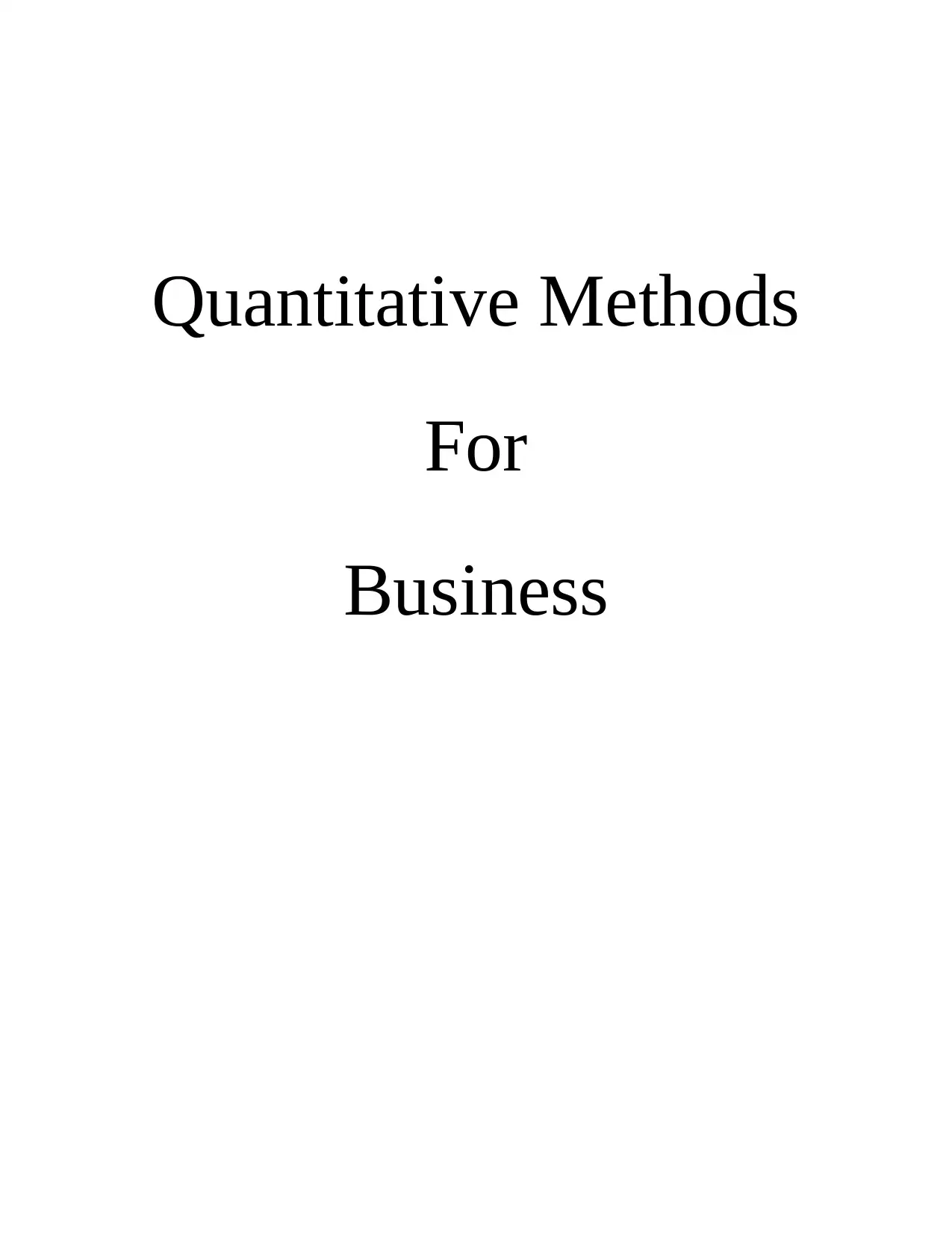
Quantitative Methods
For
Business
For
Business
Paraphrase This Document
Need a fresh take? Get an instant paraphrase of this document with our AI Paraphraser
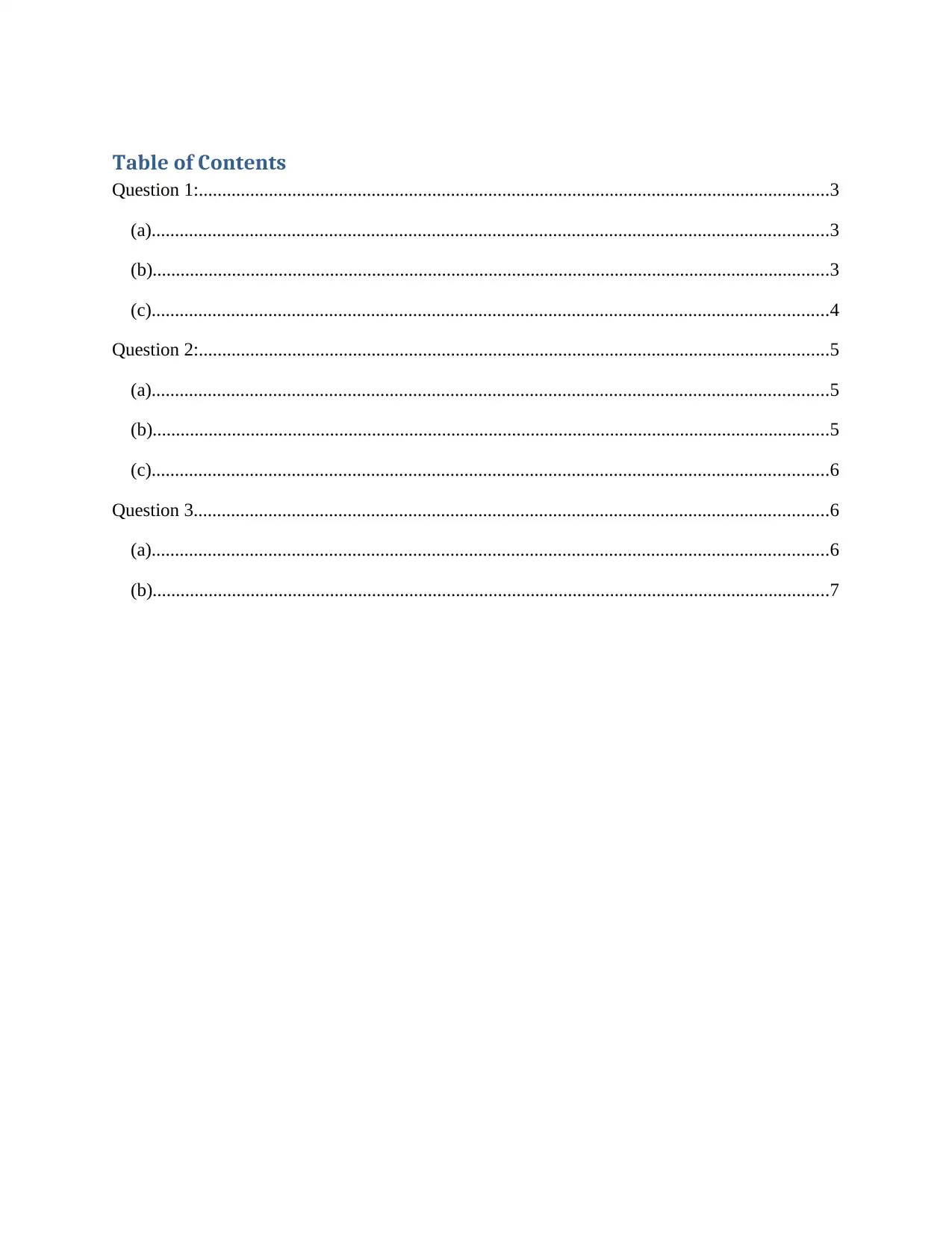
Table of Contents
Question 1:.......................................................................................................................................3
(a).................................................................................................................................................3
(b).................................................................................................................................................3
(c).................................................................................................................................................4
Question 2:.......................................................................................................................................5
(a).................................................................................................................................................5
(b).................................................................................................................................................5
(c).................................................................................................................................................6
Question 3........................................................................................................................................6
(a).................................................................................................................................................6
(b).................................................................................................................................................7
Question 1:.......................................................................................................................................3
(a).................................................................................................................................................3
(b).................................................................................................................................................3
(c).................................................................................................................................................4
Question 2:.......................................................................................................................................5
(a).................................................................................................................................................5
(b).................................................................................................................................................5
(c).................................................................................................................................................6
Question 3........................................................................................................................................6
(a).................................................................................................................................................6
(b).................................................................................................................................................7
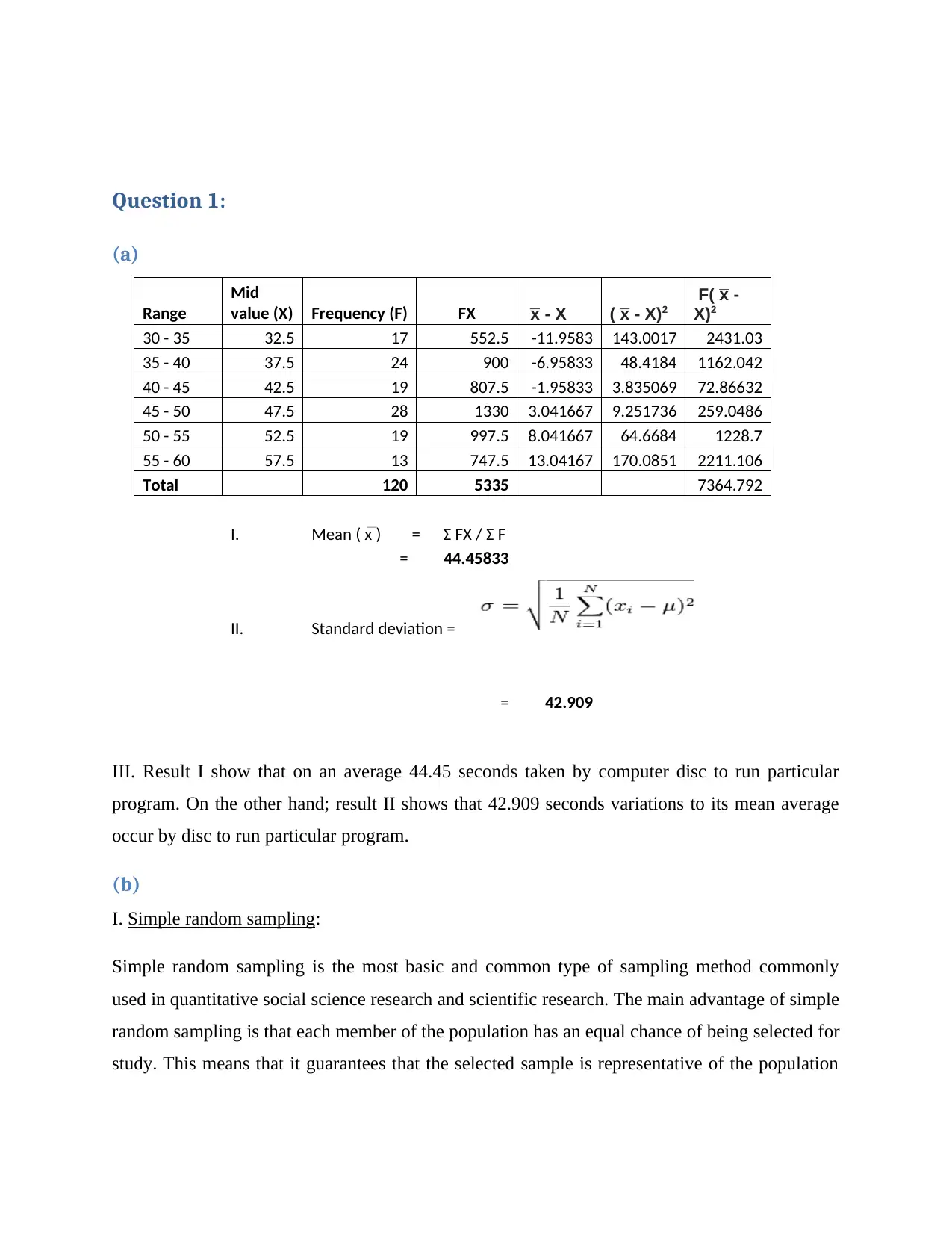
Question 1:
(a)
Range
Mid
value (X) Frequency (F) FX x̅ - X ( x̅ - X)2
F( x̅ -
X)2
30 - 35 32.5 17 552.5 -11.9583 143.0017 2431.03
35 - 40 37.5 24 900 -6.95833 48.4184 1162.042
40 - 45 42.5 19 807.5 -1.95833 3.835069 72.86632
45 - 50 47.5 28 1330 3.041667 9.251736 259.0486
50 - 55 52.5 19 997.5 8.041667 64.6684 1228.7
55 - 60 57.5 13 747.5 13.04167 170.0851 2211.106
Total 120 5335 7364.792
I. Mean ( x̅ ) = Ʃ FX / Ʃ F
= 44.45833
II. Standard deviation =
= 42.909
III. Result I show that on an average 44.45 seconds taken by computer disc to run particular
program. On the other hand; result II shows that 42.909 seconds variations to its mean average
occur by disc to run particular program.
(b)
I. Simple random sampling:
Simple random sampling is the most basic and common type of sampling method commonly
used in quantitative social science research and scientific research. The main advantage of simple
random sampling is that each member of the population has an equal chance of being selected for
study. This means that it guarantees that the selected sample is representative of the population
(a)
Range
Mid
value (X) Frequency (F) FX x̅ - X ( x̅ - X)2
F( x̅ -
X)2
30 - 35 32.5 17 552.5 -11.9583 143.0017 2431.03
35 - 40 37.5 24 900 -6.95833 48.4184 1162.042
40 - 45 42.5 19 807.5 -1.95833 3.835069 72.86632
45 - 50 47.5 28 1330 3.041667 9.251736 259.0486
50 - 55 52.5 19 997.5 8.041667 64.6684 1228.7
55 - 60 57.5 13 747.5 13.04167 170.0851 2211.106
Total 120 5335 7364.792
I. Mean ( x̅ ) = Ʃ FX / Ʃ F
= 44.45833
II. Standard deviation =
= 42.909
III. Result I show that on an average 44.45 seconds taken by computer disc to run particular
program. On the other hand; result II shows that 42.909 seconds variations to its mean average
occur by disc to run particular program.
(b)
I. Simple random sampling:
Simple random sampling is the most basic and common type of sampling method commonly
used in quantitative social science research and scientific research. The main advantage of simple
random sampling is that each member of the population has an equal chance of being selected for
study. This means that it guarantees that the selected sample is representative of the population
⊘ This is a preview!⊘
Do you want full access?
Subscribe today to unlock all pages.

Trusted by 1+ million students worldwide
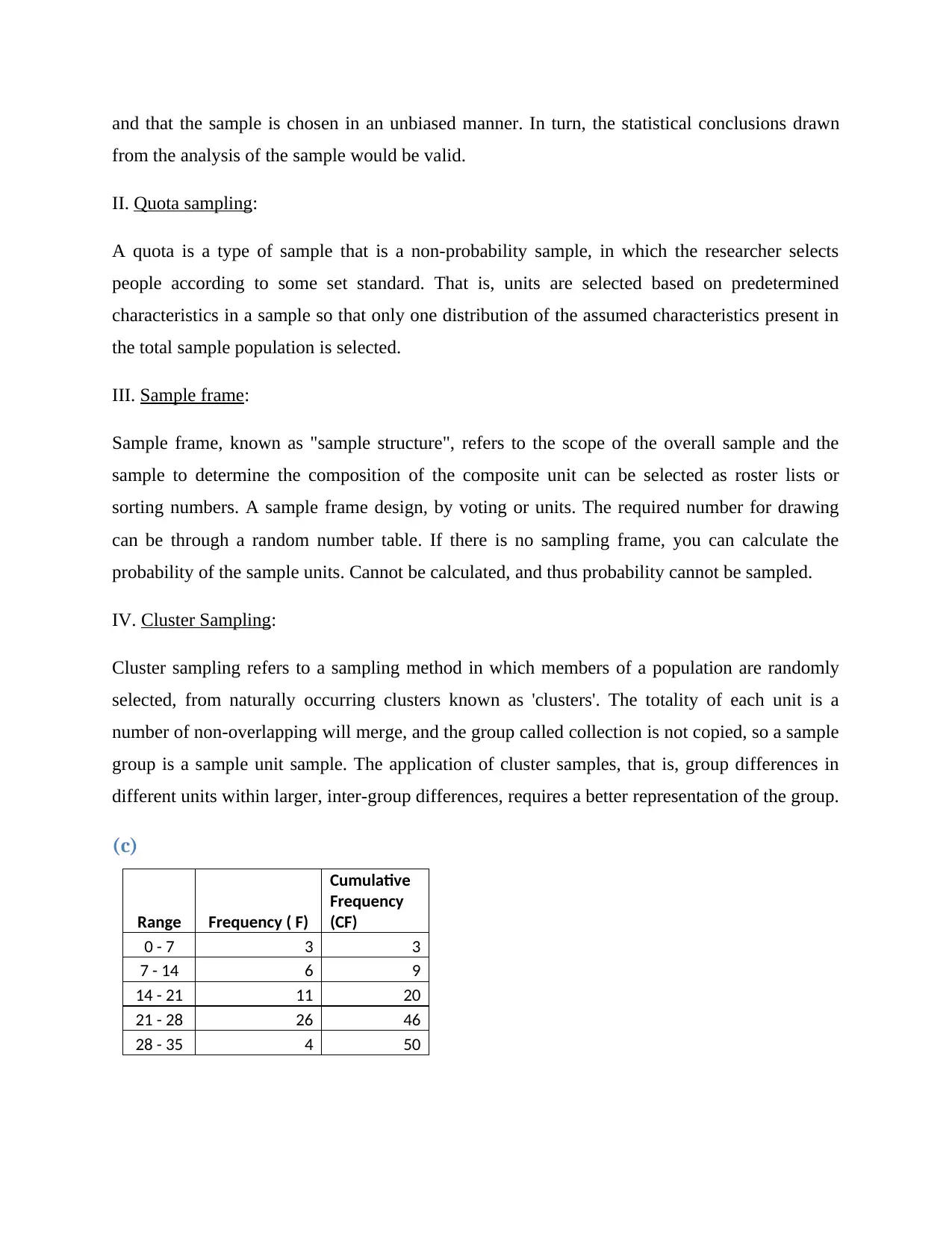
and that the sample is chosen in an unbiased manner. In turn, the statistical conclusions drawn
from the analysis of the sample would be valid.
II. Quota sampling:
A quota is a type of sample that is a non-probability sample, in which the researcher selects
people according to some set standard. That is, units are selected based on predetermined
characteristics in a sample so that only one distribution of the assumed characteristics present in
the total sample population is selected.
III. Sample frame:
Sample frame, known as "sample structure", refers to the scope of the overall sample and the
sample to determine the composition of the composite unit can be selected as roster lists or
sorting numbers. A sample frame design, by voting or units. The required number for drawing
can be through a random number table. If there is no sampling frame, you can calculate the
probability of the sample units. Cannot be calculated, and thus probability cannot be sampled.
IV. Cluster Sampling:
Cluster sampling refers to a sampling method in which members of a population are randomly
selected, from naturally occurring clusters known as 'clusters'. The totality of each unit is a
number of non-overlapping will merge, and the group called collection is not copied, so a sample
group is a sample unit sample. The application of cluster samples, that is, group differences in
different units within larger, inter-group differences, requires a better representation of the group.
(c)
Range Frequency ( F)
Cumulative
Frequency
(CF)
0 - 7 3 3
7 - 14 6 9
14 - 21 11 20
21 - 28 26 46
28 - 35 4 50
from the analysis of the sample would be valid.
II. Quota sampling:
A quota is a type of sample that is a non-probability sample, in which the researcher selects
people according to some set standard. That is, units are selected based on predetermined
characteristics in a sample so that only one distribution of the assumed characteristics present in
the total sample population is selected.
III. Sample frame:
Sample frame, known as "sample structure", refers to the scope of the overall sample and the
sample to determine the composition of the composite unit can be selected as roster lists or
sorting numbers. A sample frame design, by voting or units. The required number for drawing
can be through a random number table. If there is no sampling frame, you can calculate the
probability of the sample units. Cannot be calculated, and thus probability cannot be sampled.
IV. Cluster Sampling:
Cluster sampling refers to a sampling method in which members of a population are randomly
selected, from naturally occurring clusters known as 'clusters'. The totality of each unit is a
number of non-overlapping will merge, and the group called collection is not copied, so a sample
group is a sample unit sample. The application of cluster samples, that is, group differences in
different units within larger, inter-group differences, requires a better representation of the group.
(c)
Range Frequency ( F)
Cumulative
Frequency
(CF)
0 - 7 3 3
7 - 14 6 9
14 - 21 11 20
21 - 28 26 46
28 - 35 4 50
Paraphrase This Document
Need a fresh take? Get an instant paraphrase of this document with our AI Paraphraser

Question 2:
(a)
The meaning of four regression coefficients is as follows:
The value 0.794x and 0.427x shows positive slope; which indicates that any increase in x value
which is independent value or distance travelled will simultaneously increase Y variable which is
running cost of the car and vice a verse. On the other hand; values like 2.650 and 5.585 shows
the intersection of two regression line at single point.
(b)
New travelling distance of car F = 12.1 * 1.5 = 18.15
New travelling distance of car L = 12.3 * 1.5 = 18.45
Choices:
Total cost of car F:
Y = 2.650 + 0.794X
= 2.650 + 0.794 (18.15) = 1,698.8 pounds
Total cost of car L:
Y = 5.585 + 0.427X
= 5.585 + 0.427 (18.45) = 1,346.5 pounds
Hence, the cost of car L is low and therefore this option will be chosen for this region.
(a)
The meaning of four regression coefficients is as follows:
The value 0.794x and 0.427x shows positive slope; which indicates that any increase in x value
which is independent value or distance travelled will simultaneously increase Y variable which is
running cost of the car and vice a verse. On the other hand; values like 2.650 and 5.585 shows
the intersection of two regression line at single point.
(b)
New travelling distance of car F = 12.1 * 1.5 = 18.15
New travelling distance of car L = 12.3 * 1.5 = 18.45
Choices:
Total cost of car F:
Y = 2.650 + 0.794X
= 2.650 + 0.794 (18.15) = 1,698.8 pounds
Total cost of car L:
Y = 5.585 + 0.427X
= 5.585 + 0.427 (18.45) = 1,346.5 pounds
Hence, the cost of car L is low and therefore this option will be chosen for this region.

(c)
Car L
Distance
Travelled
Running
Costs
10%
increase
X Y
3.5 6.9 7.59
4.6 7.6 8.36
5.3 7.9 8.69
6 8.3 9.13
7.2 8.8 9.68
8.4 9.2 10.12
10.1 9.6 10.56
11.1 10.3 11.33
11.5 10.1 11.11
12.3 11.3 12.43
Mean = 8 9.9
Expected total running costs for 5 of car L in this new region next year:
= 8 × 9.9× 5
= 39,600 pounds
Question 3
(a)
Probability of Chris not solving the problem P (C’) = 1− 1
6 = 5
6
Probability of Albert not solving the problem P (A’) = 1− 1
8 = 7
8
Probability of John not solving the problem P (J’) = 1− 1
3 = 2
3
I. Probability of none of them solves the problem = P (C’). P (A’). P (J’)
Car L
Distance
Travelled
Running
Costs
10%
increase
X Y
3.5 6.9 7.59
4.6 7.6 8.36
5.3 7.9 8.69
6 8.3 9.13
7.2 8.8 9.68
8.4 9.2 10.12
10.1 9.6 10.56
11.1 10.3 11.33
11.5 10.1 11.11
12.3 11.3 12.43
Mean = 8 9.9
Expected total running costs for 5 of car L in this new region next year:
= 8 × 9.9× 5
= 39,600 pounds
Question 3
(a)
Probability of Chris not solving the problem P (C’) = 1− 1
6 = 5
6
Probability of Albert not solving the problem P (A’) = 1− 1
8 = 7
8
Probability of John not solving the problem P (J’) = 1− 1
3 = 2
3
I. Probability of none of them solves the problem = P (C’). P (A’). P (J’)
⊘ This is a preview!⊘
Do you want full access?
Subscribe today to unlock all pages.

Trusted by 1+ million students worldwide
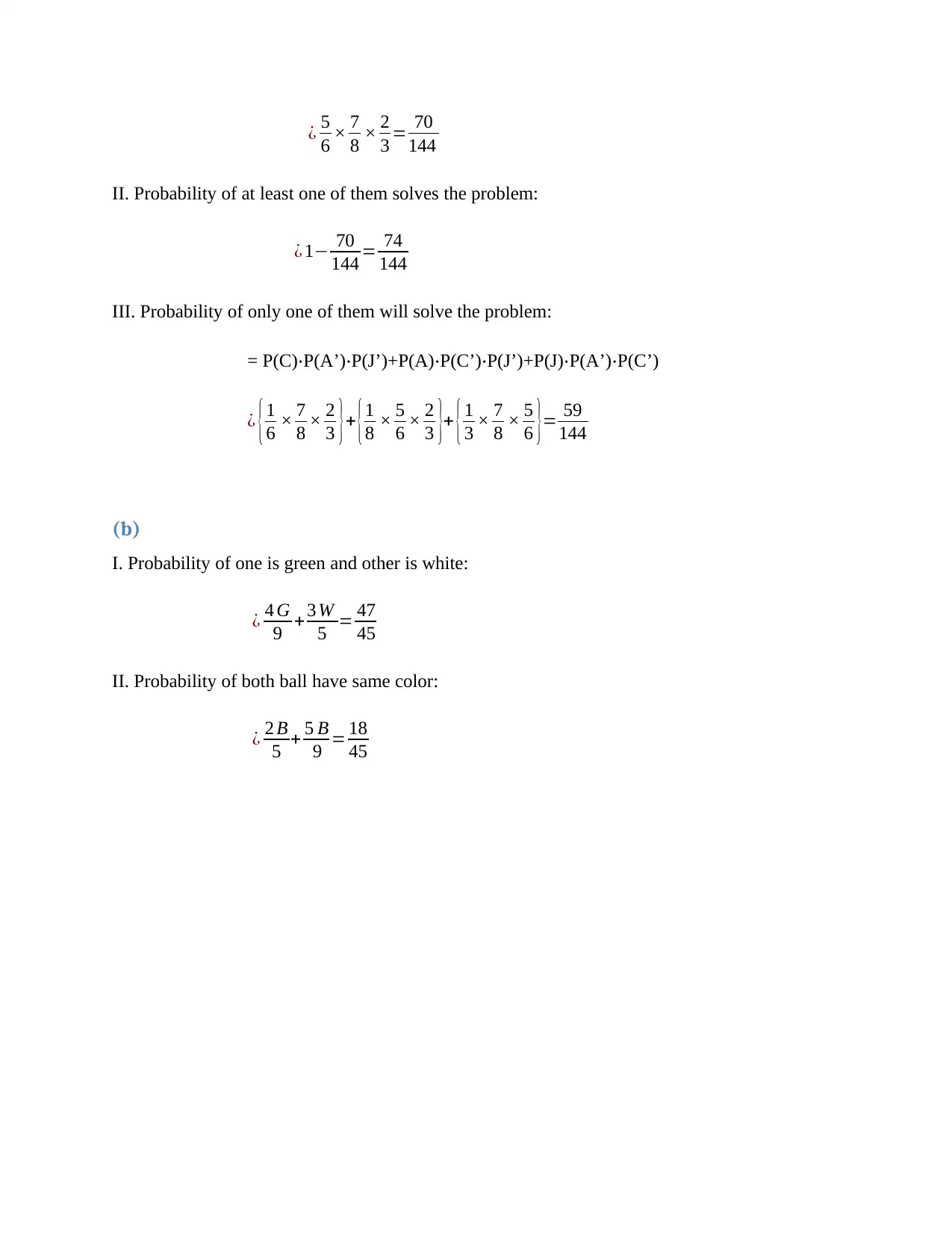
¿ 5
6 × 7
8 × 2
3 = 70
144
II. Probability of at least one of them solves the problem:
¿ 1− 70
144 = 74
144
III. Probability of only one of them will solve the problem:
= P(C)⋅P(A’)⋅P(J’)+P(A)⋅P(C’)⋅P(J’)+P(J)⋅P(A’)⋅P(C’)
¿ {1
6 × 7
8 × 2
3 }+ {1
8 × 5
6 × 2
3 }+ {1
3 × 7
8 × 5
6 }= 59
144
(b)
I. Probability of one is green and other is white:
¿ 4 G
9 + 3 W
5 = 47
45
II. Probability of both ball have same color:
¿ 2 B
5 + 5 B
9 = 18
45
6 × 7
8 × 2
3 = 70
144
II. Probability of at least one of them solves the problem:
¿ 1− 70
144 = 74
144
III. Probability of only one of them will solve the problem:
= P(C)⋅P(A’)⋅P(J’)+P(A)⋅P(C’)⋅P(J’)+P(J)⋅P(A’)⋅P(C’)
¿ {1
6 × 7
8 × 2
3 }+ {1
8 × 5
6 × 2
3 }+ {1
3 × 7
8 × 5
6 }= 59
144
(b)
I. Probability of one is green and other is white:
¿ 4 G
9 + 3 W
5 = 47
45
II. Probability of both ball have same color:
¿ 2 B
5 + 5 B
9 = 18
45
1 out of 7
Related Documents
Your All-in-One AI-Powered Toolkit for Academic Success.
+13062052269
info@desklib.com
Available 24*7 on WhatsApp / Email
![[object Object]](/_next/static/media/star-bottom.7253800d.svg)
Unlock your academic potential
Copyright © 2020–2025 A2Z Services. All Rights Reserved. Developed and managed by ZUCOL.




